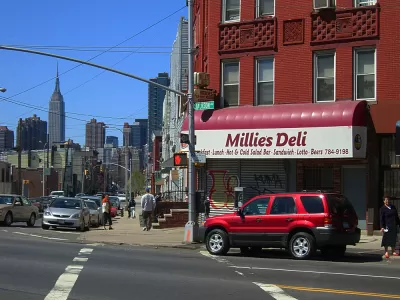The wisdom of a broad cross section of residents and stakeholders is an essential part of planning and designing livable, efficient, and authentic communities.

Nolan Gray writes on the dialectic between top-down planning practices, like those that peaked during the 20th century, and a mote bottom-up model, evident in places designed and built before the advent of zoning. Gray's preference, as is made clear, is for the latter.
In the first article of a two-art series, Gray begins to build a case for bottom-up urban planning and design by listing the shortcomings of the top-down model.
There are two issues with this system: First, planners often lack the knowledge needed to know when to attempt to control urban design at all. Unlike traditional externalities, such as noise, smoke, light, or odor, “good” and “bad” design are ambiguous and subject to disagreement among reasonable people. A design that might seem to you like a disruptive and ugly oddball might seem to someone else like a welcome and exciting bit of variation.
More details re provided to make that first point before eventually moving to the second point:
Second, even if planners could identify circumstances in which design regulation was appropriate, we (I say this as a practicing planner myself) lack the knowledge needed to actually set design standards for every single lot, even at a small scale.
And after adding more detail in the article on that second point, Gray adds this coda:
Centralized urban design is further undermined by the fact that conditions in a healthy city are constantly changing. Cultural preferences related to design features such as setbacks evolve. Rising land values may mean that future buildings need to economize on land and build up. Even if we could all agree at a given time that a block needs top-down design regulations, that these regulations should be X, Y, and Z, and that these standards are feasible under present market conditions, conditions will almost certainly change in the future. In addition to learning from past mistakes, a distributed system of urban design provides those with skin in the game the power to iterate and modify inherited practices, testing out new urban design configurations.
To show what a bottom-up model looks like in practice, Gray turns to the example of setbacks in eastern Queens in the second article in the series. There, neighborhoods like Astoria and Long Island City emerged without the extra regulations and process required of master planning, urban design guidelines, or form-based codes. The font setback, also known as the front yard, provides an example of the market and local knowledge producing results that fit the context of the community.
"We realize in the front setback—as you might realize in any number of other urban design trends—that cities naturally possess the power to understand and reformulate themselves as conditions change. This occurs not through evolution in the best-practices of planners, but through a much messier and more organic process involving millions of decentralized decisions," concludes Gray.
FULL STORY: Why Urban Design Should Come From the Bottom (Part 1)

Alabama: Trump Terminates Settlements for Black Communities Harmed By Raw Sewage
Trump deemed the landmark civil rights agreement “illegal DEI and environmental justice policy.”

Study: Maui’s Plan to Convert Vacation Rentals to Long-Term Housing Could Cause Nearly $1 Billion Economic Loss
The plan would reduce visitor accommodation by 25% resulting in 1,900 jobs lost.

Planetizen Federal Action Tracker
A weekly monitor of how Trump’s orders and actions are impacting planners and planning in America.

Wind Energy on the Rise Despite Federal Policy Reversal
The Trump administration is revoking federal support for renewable energy, but demand for new projects continues unabated.

Passengers Flock to Caltrain After Electrification
The new electric trains are running faster and more reliably, leading to strong ridership growth on the Bay Area rail system.

Texas Churches Rally Behind ‘Yes in God’s Back Yard’ Legislation
Religious leaders want the state to reduce zoning regulations to streamline leasing church-owned land to housing developers.
Urban Design for Planners 1: Software Tools
This six-course series explores essential urban design concepts using open source software and equips planners with the tools they need to participate fully in the urban design process.
Planning for Universal Design
Learn the tools for implementing Universal Design in planning regulations.
Caltrans
Smith Gee Studio
Institute for Housing and Urban Development Studies (IHS)
City of Grandview
Harvard GSD Executive Education
Toledo-Lucas County Plan Commissions
Salt Lake City
NYU Wagner Graduate School of Public Service





























